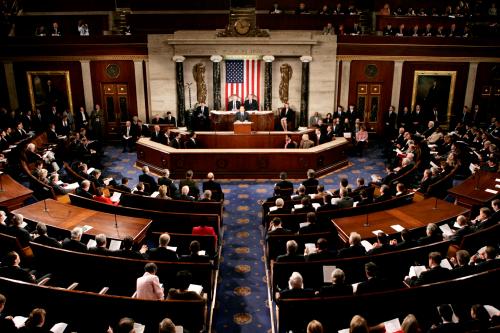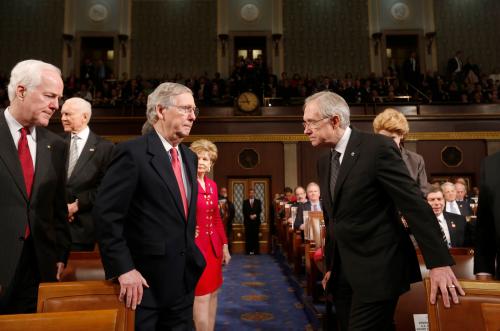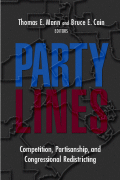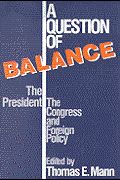Editor’s Note: In testimony before the U.S. Senate Committee on Rules and Administration, Sarah Binder counters a number of conventionally held notions about the origins and history of the Senate filibuster. Binder notes that the filibuster was not part of the original design of the Senate and the creation of the cloture rule was not a statement of the Senate’s love for supermajority rules, but rather the product of hard-nose bargaining with an obstructive minority.
Chairman Schumer, Ranking Member Bennett, and members of the Committee. My name is Sarah Binder. I am a senior fellow at the Brookings Institution and a professor of political science at George Washington University. I appreciate the opportunity to testify today about the history of the filibuster.
I want to offer three arguments today about that history.
First, historical lore says that the filibuster was part of the original design of the Senate. Not true. When we scour early Senate history, we discover that the filibuster was created by mistake.
Second, we often say that the 19th century Senate was a golden age of deliberation. But the golden age was not so golden: Senate leaders by the 1840s were already trying to adopt a cloture rule. But most such efforts to bar the filibuster were filibustered.
Third, creation of the cloture rule in 1917 was not a statement of the Senate’s love for supermajority rules. Instead, it was the product of hard-nose bargaining with an obstructive minority. Short-term, pragmatic politics shape contests to change Senate rules.
Allow me to elaborate on these three points.
1. Origins of the filibuster [1]
We have many received wisdoms about the filibuster. However, most of them are not true. The most persistent myth is that the filibuster was part of the founding fathers’ constitutional vision for the Senate: It is said that the upper chamber was designed to be a slow-moving, deliberative body that cherished minority rights. In this version of history, the filibuster was a critical part of the framers’ Senate.
However, when we dig into the history of Congress, it seems that the filibuster was created by mistake. Let me explain.
The House and Senate rulebooks in 1789 were nearly identical. Both rulebooks included what is known as the “previous question” motion. The House kept their motion, and today it empowers a simple majority to cut off debate. The Senate no longer has that rule on its books.
What happened to the Senate’s rule? In 1805, Vice President Aaron Burr was presiding over the Senate (freshly indicted for the murder of Alexander Hamilton), and he offered this advice. He said something like this. You are a great deliberative body. But a truly great Senate would have a cleaner rule book. Yours is a mess. You have lots of rules that do the same thing. And he singles out the previous question motion. Now, today, we know that a simple majority in the House can use the rule to cut off debate. But in 1805, neither chamber used the rule that way. Majorities were still experimenting with it. And so when Aaron Burr said, get rid of the previous question motion, the Senate didn’t think twice. When they met in 1806, they dropped the motion from the Senate rule book.
Why? Not because senators in 1806 sought to protect minority rights and extended debate. They got rid of the rule by mistake: Because Aaron Burr told them to.
Once the rule was gone, senators still did not filibuster. Deletion of the rule made possible the filibuster because the Senate no longer had a rule that could have empowered a simple majority to cut off debate. It took several decades until the minority exploited the lax limits on debate, leading to the first real-live filibuster in 1837.
2. The Not-So-Golden Age of the Senate
Conventional treatments of the Senate glorify the 19th century as the “golden age” of the Senate: We say that filibusters were reserved for the great issues of the day and that all senators cherished extended debate. That view misreads history in two ways.
First, there were very few filibusters before the Civil War. Why so few filibusters? First, the Senate operated by majority rule; senators expected matters would be brought to a vote. Second, the Senate did not have a lot of work to do in those years, so there was plenty of time to wait out the opposition. Third, voting coalitions in the early Senate were not nearly as polarized as they would later become.
All that changed by mid-century. The Senate grew larger and more polarized along party lines, it had more work to do, and people started paying attention to it. By the 1880s, almost every Congress began to experience at least one bout of obstructionism: for instance, over civil rights, election law, nominations, even appointment of Senate officers—only some of these “the great issues of the day.”
There is a second reason that this was not a golden age: When filibusters did occur, leaders tried to ban them. Senate leaders tried and failed repeatedly over the course of the 19th and early 20th centuries to reinstate the previous question motion. More often than not, senators gave up their quest for reform when they saw that opponents would kill it by filibuster—putting the majority’s other priorities at risk. Unable to reform Senate rules, leaders developed other innovations such as unanimous consent agreements. These seem to have been a fallback option for managing a chamber prone to filibusters.
3. The adoption of cloture
Why was reform possible in 1917 when it had eluded leaders for decades? And why did the Senate choose supermajority cloture rather than simple majority cloture? [2]
First, the conditions for reform. After several unsuccessful efforts to create a cloture rule in the early 1900s, we saw a perfect storm in March of 1917: a pivotal issue, a president at his bully pulpit, an attentive press, and a public engaged in the fight for reform. At the outset of World War I, Republican senators successfully filibustered President Wilson’s proposal to arm merchant ships—leading Wilson in March of 1917 to famously brand the obstructionists as a “little group of willful men.” He demanded the Senate create a cloture rule, the press dubbed the rule a “war measure,” and the public burned senators in effigy around the country.
Adoption of Rule 22 occurred because Wilson and the Democrats framed the rule as a matter of national security. They fused procedure with policy, and used the bully pulpit to shame senators into reform.
Second, why did senators select a supermajority rule? A bipartisan committee was formed to negotiate the form of the rule. Five of the six Democrats supported a simple majority rule; one Republican supported a supermajority rule, and one Republican preferred no rule. Negotiators cut a deal: Cloture would require two-thirds of senators voting. Opponents promised not to block or weaken the proposal; supporters promised to drop their own proposal for simple majority cloture—a proposal supported by at least 40 senators. The cloture rule was then adopted, 76-3.
4. Conclusions
We can draw at least three lessons from this history:
First, the history of extended debate in the Senate belies the received wisdom that the filibuster was an original, constitutional feature of the Senate. The filibuster is more accurately viewed as the unanticipated consequence of an early change to Senate rules.
Second, reform of Senate rules is possible. There are conditions that can lead a bipartisan supermajority to agree to change Senate rules. The minority has often held the upper hand in these contests, however, given the high barrier to reform imposed by inherited Senate rules.
Third, and finally, the Senate adopted a supermajority rule not because senators were uniformly committed to the filibuster. Senators chose a two-thirds rule because a minority blocked more radical reform. Short-term, pragmatic considerations almost always shape contests over reform of Senate rules.
[1] The following discussion is largely drawn from Sarah A. Binder and Steven S. Smith, Politics or Principle? Filibustering in the United States Senate (Brookings Institution Press, 1997).
[2] On the politics of amending Rule 22 in 1917, in addition to Binder and Smith (1997), see Gregory Koger, “Filibuster Reform in the Senate, 1913-1917,” in Party, Process, and Political Change in Congress, V. 2, David Brady and Mathew McCubbins, Eds. (Stanford University Press, 2007), pp. 205-25; see also Gregory Wawro and Eric Schickler, Filibuster (Princeton University Press, 2006).
The Brookings Institution is committed to quality, independence, and impact.
We are supported by a diverse array of funders. In line with our values and policies, each Brookings publication represents the sole views of its author(s).










Commentary
TestimonyThe history of the filibuster
April 22, 2010